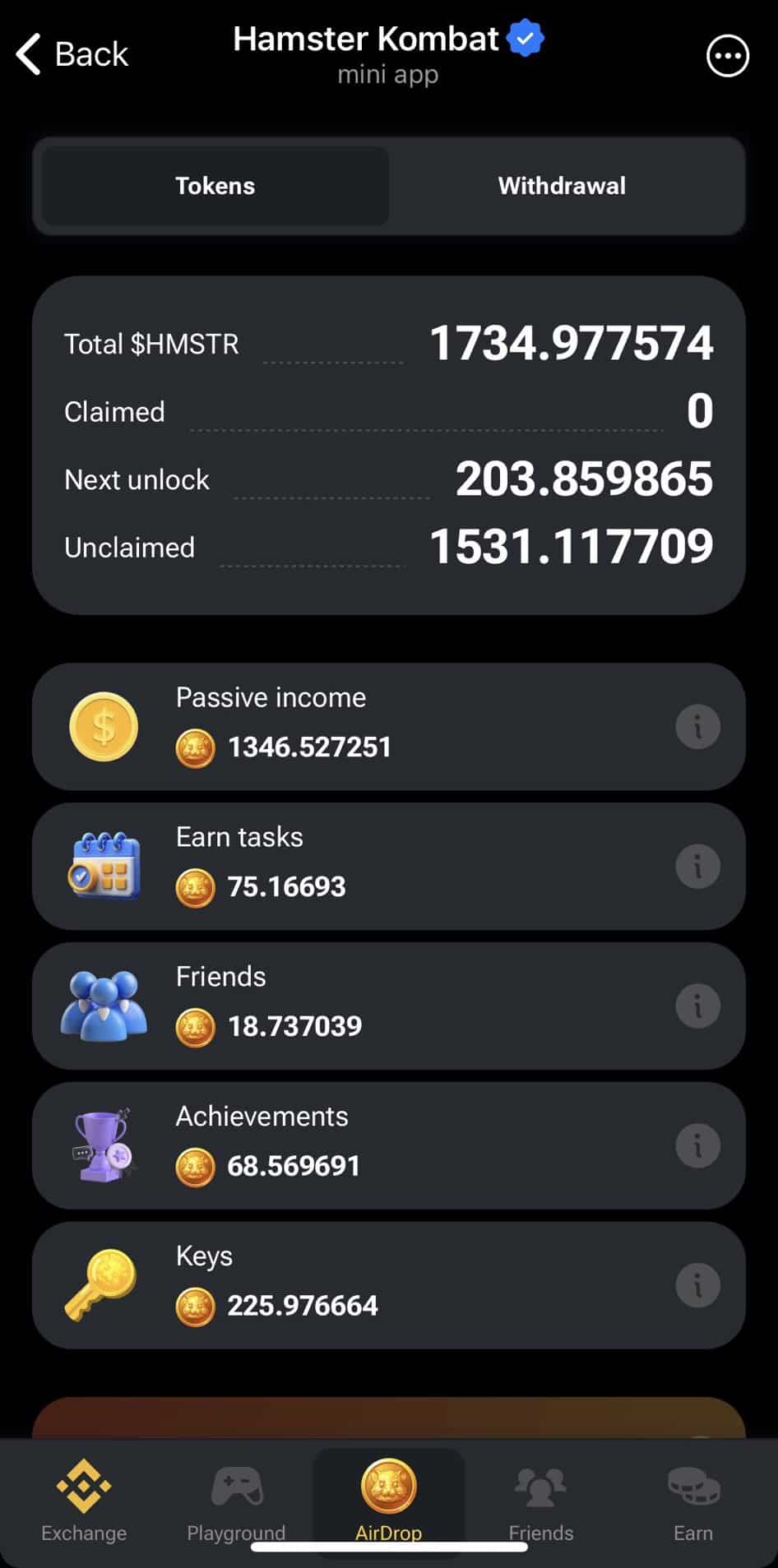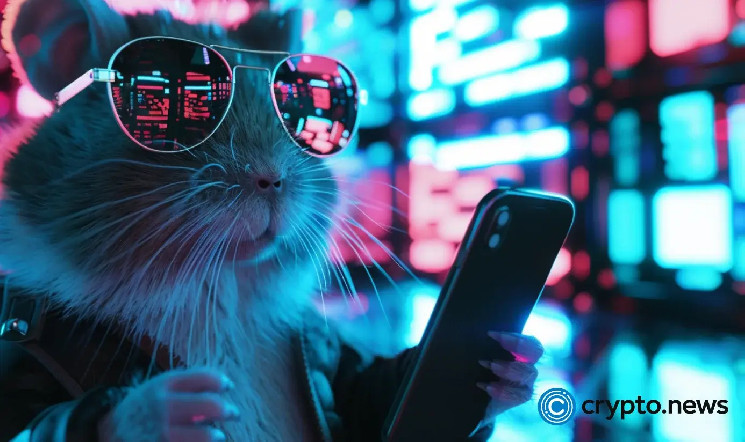Hamster Kombat has finally allocated HMSTR to users a few days before the official airdrop. But token allocation details have left many players upset.
Whether you’re one of the millions of avid players of the Telegram-based tap-to-earn game Hamster Kombat, or you’ve managed to ignore it entirely, the hype around the game since its launch this spring is very real.
Most of the news around the game has been focused on shifting information around the much anticipated launch of the game’s native token, HMSTR, and its predicted price. Now, as the game ends its first season since launching in March, the team behind it is receiving attention for a very different reason. Players are calling out the team and accusing them of unfair treatment and false promises.
We took a look at what happened and what to expect in the coming days leading up to the token launch later this week.
As of this weekend, as part of the game’s promised reward system, gamers’ accumulated resources have been converted into allocated HMSTR tokens, which are supposed to be sent to them as actual tokens at launch. In an X post, the team behind the game revealed more information about the token supply and allocation. The team stated that out of the set supply of 100 billion HMSTR tokens to be minted, 75% will be reserved for the community. After the end of the first season — meaning now — 60% of this amount will be available to the game’s users.
✍️ HAMSTER MATH ✍️
— Hamster Kombat (@hamster_kombat) September 22, 2024
🔥 The results of Season 1 have been finalized:
🚀 Over 300 million people have joined Hamster Kombat since March 26, 2024, 131 million qualified for the airdrop on September 26th and around 2.3 million were banned as cheaters.
📤 30.6 million of qualified… pic.twitter.com/LH5eD3i8al
As laid out in the team’s X post, the “hamster math” continues: of the 60% of HMSTR token supply allocated to users, 88.75% will be distributed during the token airdrop and listing this week, while the remaining portion will be vested and become available only ten months after the token is listed on exchanges. The team also promised to airdrop an additional 15% of the 100 billion tokens during the upcoming second season of the Hamster Kombat game.
Since March, according to the Hamster Kombat team, a whopping 300 million people have signed up to play the game. Of these, a little under half of the players — 131 million in total — qualified to receive HMSTR tokens in the much-anticipated airdrop, scheduled for Sept. 26. In addition, 2.3 million were considered cheaters and banned from the token distribution entirely.
Token distribution leaves many disappointed
Since the Hamster Kombat team posted their announcement on Sunday, many users have taken to X to express their dissatisfaction with the token distribution process and criteria, noting that they received fewer tokens than they expected for their time and effort. Evidently, the results were especially disappointing in dollar terms, based on the price of HMSTR in so-called pre-market trading.
The token is set to be listed and made available for trading on exchanges following the airdrop later this week. But thanks to the pre-market trading of spot and futures contracts for the yet to be listed HMSTR token on several major exchanges, its price varies from 0.01 USDT to 0.1 USDT on different platforms, leaving players with little sense of the value of their allocated tokens.
Judging by the comments in community, the average user received less than $50 for hundreds of hours of play, based on the highest USDT price across exchanges.
One of the users of the Telegram community with the nickname Timbo told crypto.news that he had started playing the game almost from the very beginning. Timbo said he played about 4-5 hours a day for two months and earned about 500 tokens. As time passed, the hype around the game and the upcoming token launch continued to increase, and that meant a growing number of players who were all promised token allocations at launch.
“Over time, my interest disappeared. The game itself is not that interesting. As for potential earnings, I didn’t think I should expect much — the number of players has become incredibly large, and everyone needs to be rewarded.”
Timbo, a Hamster Kombat player
Ban on “cheaters” raises questions
An even greater wave of negativity was caused by the announcement that a large group of players — 2.3 million to be exact — would be excluded from the token distribution. According to the project, the ban was put in place to address those users who had reportedly tried to cheat the game — for example by using multiple devices for tapping or playing from different accounts, or cheating with referrals.
Some of the criteria for cheating were more controversial. For example, the most reportedly shocking punishment was for buying keys. To get keys in the game according to the rules, users have to complete a mini-game. But some just bought the keys instead of completing the mini game. The game’s system let users buy keys without issuing warnings or explaining that it was against the rules. The action was apparently later considered “cheating,” and reportedly resulted in being banned from receiving tokens. Several members of one Hamster Kombat Telegram chat posted a message that included the statement:
“Some of my friends, who have committed no wrongdoing, have been mistakenly included in the cheaters list. This unfairness has severely damaged the community’s trust and created a climate of mistrust.”
Players who the project considered to have violated the games rules — which evidently weren’t clearly stated — were given a status at the end of Season 1 that reads simply: “cheating is bad.” The Hamster Kombat community Telegram chats immediately overflowed with complaints, calling the criteria for distribution unfair and asking the admins to reconsider and distribute tokens. Users in Telegram expressed dissatisfaction with the fact that the “cheating” status was given only at the very end of the season, after they had already spent a lot of time playing:
“When the project started, it was not known what violations could happen, and at the end of the project, bans were put in place to give coins to fewer people with ridiculous excuses.”
In addition, one self-reported player complained on X that they had played for four months, collected more than 200 keys, earned 8.36 million (evidently HMSTR) every hour, set alarms and followed the “rising times of the cards.”
“Now you’re telling me I don’t deserve it. Hamster is a cheater.”
Meanwhile, the hashtag #boycotthamsterkombat is trending on X — at the time of writing, the number of tweets with this tag exceeded 22,000.
How is token allocation determined?
According to community reports, the amount of tokens awarded was determined based on the following criteria:
- How many coins the user has collected over the entire period
- How many friends the user has invited to the game
- How many coins the user has received through passive income
- How many keys the user has earned in mini-games
- How many daily tasks the user has completed
The tokens earned in Hamster Kombat are divided into several categories: Total HMSTR, Claimed, Next Unlock, and Unclaimed. However, the game does not provide any explanations of the different categories.

As it turns out, the most important task for determining the number of tokens to be distributed to each player was not the HMSTER tokens earned as passive income for playing the game, but the number of friends invited by referral link. Judging by comments in social media, it is ordinary users who are the most upset by the token allocation logic, as they were the ones who spent time actually playing, trying to get into the top 100 players, completing tasks, etc. These players, the core of the “community,” likely didn’t have the social reach of, say, a YouTube influencer, who could share their referral link widely to invite “friends,” and thus earn more tokens.
Did Hamster Kombat fool everyone?
With its large-scale token distribution plan and reported usage statistics, the Hamster Kombat airdrop is still expected to be one of the largest in the crypto space. Players who have linked wallets to their Hamster Kombat account are indeed expected to receive their allocated tokens in the airdrop evetn this week and then be able to trade them on major exchanges like Binance and OKX.
When considering the massive number of users who reportedly play Hamster Kombat, it is perhaps unsurprising that players received fewer coins than expected. With a set total token supply capped at 100 billion and a reported user base of hundreds of millions, the math has become at least somewhat clear, if disappointing for most players.
In any case, the value that users have earned in fiat terms won’t actually be clear until HMSTR is listed for spot trading on Sept 26, and players actually receive their long-awaited tokens.
